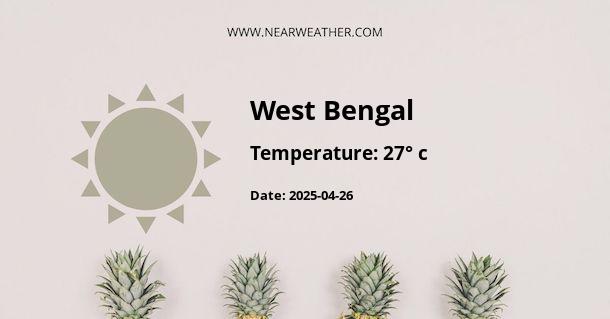A Comprehensive Guide to the Climate and Weather of West Bengal, India
West Bengal, a state located in Eastern India, is well-known for its diverse culture, heritage, and weather. The unique geographical features of West Bengal contribute to its varied climate ranging from the alpine in the Himalayas to the tropical in the coastal regions.Geographical Overview
West Bengal, covering an area of 88,752 square kilometers, is nestled between the Himalayas in the north and the Bay of Bengal in the south, stretching over latitudes 21°31'20" North to 27°13'15" North and longitudes 85°50'20" East to 89°53'04" East. The state is divided into two broad natural divisions: the Gangetic Plain and the sub-Himalayan and Himalayan area in the north.
Seasonal Variations and Weather
In West Bengal, weather conditions can be broadly classified into four main seasons: Summer, Monsoon, Autumn, and Winter.
- Summer (April to Mid-June): Summers are hot and humid, particularly in the Gangetic plains, where temperatures can reach up to 40°C. In the Himalayan region, the weather remains pleasant with temperatures hovering around 20°C.
- Monsoon (Mid-June to September): West Bengal receives heavy rainfall during the monsoon, particularly in the Himalayan region which can receive up to 3000mm of rainfall annually. The Gangetic plains also receive a significant amount of rainfall, contributing to the agricultural richness of the region.
- Autumn (October to November): This is considered the best time to visit West Bengal as the weather is pleasant with moderate temperatures and less humidity. During this season, many famous festivals like Durga Puja are celebrated.
- Winter (December to March): Winters are mild in the plains with temperatures dropping to around 12°C, while in the Himalayan region, it can drop below 0°C with heavy snowfall.
Climate Zones
Due to its diverse geographical features, West Bengal can be divided into various climate zones:
Tropical Savanna: The Gangetic plains fall under this category, characterized by high temperatures and moderate rainfall.
Humid Subtropical: This climate is found in the area south of the Gangetic plains, featuring hot summers and cool winters.
Alpine: The Himalayan region of West Bengal falls under this category, with cold winters and mild summers.
Average Annual Temperatures and Rainfall
Average temperatures in West Bengal vary greatly depending on the region. The table below shows the average temperatures and rainfall in two major areas: Kolkata (Gangetic Plains) and Darjeeling (Himalayan Region).
| Kolkata | Darjeeling | |
|---|---|---|
| Average High Temperature | 32°C | 14.9°C |
| Average Low Temperature | 25°C | 8.9°C |
| Annual Rainfall | 1582mm | 3092mm |
Conclusion
From the sultry summers of the plains to the cool winters of the Himalayas, West Bengal offers a unique blend of climates that is rarely found in other Indian states. Its diverse weather patterns and seasonal variations make it an interesting destination for tourists and climatologists alike.
Whether you're planning a visit or conducting a climatic study, understanding the weather patterns and climate zones of West Bengal is crucial. Regardless of the season, West Bengal always has something unique and beautiful to offer, be it the lush green tea gardens of Darjeeling in the monsoon or the vibrant cultural celebrations of Kolkata in the autumn.
References
- Climate of West Bengal, India Meteorological Department
- Weather and Climate guide, Lonely Planet
- West Bengal, Encyclopaedia Britannica
- Climate: West Bengal, Climate-Data.org
A - West Bengal's Latitude is 24.000000 & Longitude is 88.000000.
A - Weather in West Bengal is 27° today.
A - Climate Conditions in West Bengal shows clear sky today.
A - Humidity in West Bengal is 81% today.
A - Wind speed in West Bengal is 18.5 km/h, flowing at 181° wind direction. today.
